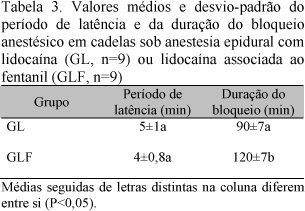The effects of lidocaine or lidocaine associated with fentanyl for epidural anesthesia in dogs were studied. Eighteen adult healthy bitches were sedated with acepromazine, with subsequent propofol anesthetic induction for the accomplishment of lumbosacral puncture. The animals were alloted in two groups and received: 8.5mg/kg lidocaine (GL group) or 5µg/kg fentanyl associated with 6.5mg/kg (GLF group). Heart and respiratory rates, systolic arterial blood pressure, blood gas variables, plasmatic concentration of cortisol, need of complementary doses of propofol for surgery, rectal temperature, and onset and duration of anesthesic block were measured. Mild alterations in the cardiorespiratory, blood gas variables and plasmatic concentration of cortisol were observed after the epidural anesthesia in both groups. There was no statistical significance in the onset and duration of anesthesic block. Complementary doses of propofol were necessary in 40% and 75% of the dogs in GLF and GL, respectively. The anesthesic protocols inhibited the elevation of the plasmatic concentration of cortisol, causing minimal cardiopulmonary alterations in the animals. Besides, the addition of fentanyl showed best results compared to the local anesthesic isolatedly.
bitch; lidocaine; fentanyl; cortisol; epidural



